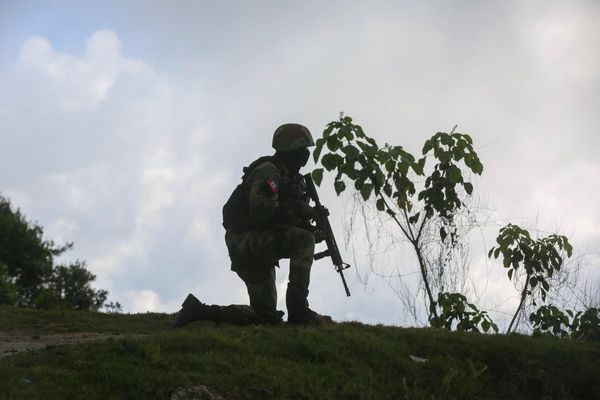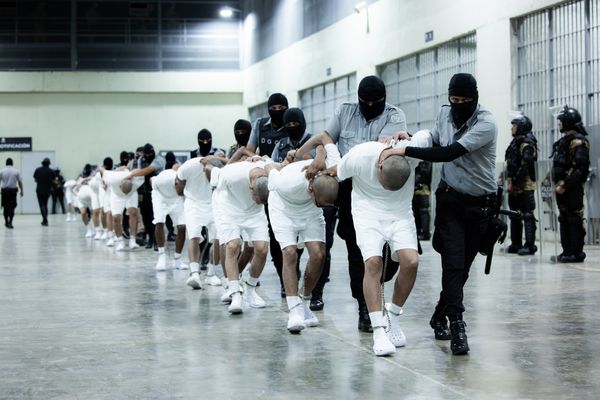
Artist and opal miner George Cooley has created his biggest landscape yet for the Adelaide Biennial, stretching across the foyer of the Art Gallery of South Australia.
His triptych of the Kaṉku-Breakaways north of Coober Pedy depicts a spectacular desert scene, but its opalescent colours are also a story of what lies beneath the surface, for the exhibition on the theme Inner Sanctum.
The painting is on show just near a display case featuring the finest cut of opal ever mined in Australia, the priceless Virgin Rainbow gemstone, on loan from the South Australian Museum.
It's one of countless juxtapositions across the 18th biennial curated by José Da Silva, which features the work of 24 leading Australian contemporary artists.

A crowd favourite when AAP visited was a large suite of nostalgic oil paintings by Clara Adolphs, hung floor to ceiling in a room on the gallery's lower floor, where gallery-goers paused for an extended look.
The pictures are based on found photographs, showing people at leisure or on holiday, bathed in an eerie white light of negative space - these are images from the past, but who and where and when remain a mystery.
Three-time Archibald finalist and Sulman Prize winner Marikit Santiago's paintings on cardboard instead trade on familiarity - her work features her husband and children cast in mythological scenes and surrounded by lush tropical imagery and folkloric iconography.
Santiago, from NSW, created a new work for the exhibition, and for those who look closely there are images of creatures burnt onto the picture with a soldering iron, as well as tiny additions by her kids.
"I just love the combination of the virtuosic painting process, but at the same time, she's incorporated kids' drawings - all these crazy creatures are drawn by her children," said the gallery's assistant director Dr Lisa Slade.
The exhibition extends throughout the entire gallery, as well as being interspersed with the permanent collection on the ground floor.
Large-scale embroideries by Victorian artist Teelah George, for example, are installed above the gallery's atrium - the first time her ambitious Sky Piece project has been displayed alongside her earlier works.
Yet one embroidery is hung separately, amongst the gallery's permanent collection, adjacent to impressionist paintings by John Russell and Charles Conder.
"She takes this laborious hand stitching which is very freeform and expressive, not unlike their expressive gestures," said Dr Slade.
The 18th biennial is the first in which poetry has been granted significant prominence, she said, with Jazz Money's poem This Is How We Love heard coming from a cluster of speakers suspended from the ceiling of the gallery, in a musical performance by the Sydney Gay and Lesbian Choir.
Painting is also more prominent in this exhibition than it has been in recent biennials, according to Dr Slade, but there is also a great variety of installation art.
One standout is Jasmine Togo-Brisby's As Above, So Below, composed of hundreds of replica Tam tam (slit drum) sculptures cast in plaster, laid on the gallery floor to form the outline of a ship.
Its size, colour and symmetry make for a sense of tranquillity at first glance, but the artwork is a reflection on the South Sea Islanders brought to Australia as indentured labourers.
Yet more discomfiting work is Jacobus Capone's video installation across three giant screens, which shows the artist scraping a knife across the face of a glacier as tiny shards of ice splay out.
It almost goes without saying that artificial intelligence gets a look too - Naked Souls by Paul Knight is a conversation between the artist and his lover, generated from a source text of all the text messages the pair have ever sent - using AI their love can go on forever.
Ultimately Inner Sanctum is about sacred spaces, refuge and sanctuary, said Dr Slade.
A final contemplative glass sculpture by Jessica Loughlin, in collaboration with the late designer Khai Liew, is about solace, this time in the face of death.
A much-loved South Australian furniture designer and craftsman, Liew died in late 2023, with the biennial project completed after his death: a large circle of opaque kiln-made glass that changes with the light outside.
"Artists get to live on, it's a good gig from that perspective, not everybody gets to leave so much of themselves behind," said Dr Slade.
The Adelaide Biennial of Australian Art: Inner Sanctum runs until June 2 as part of the Adelaide Festival.
AAP travelled with the assistance of the Adelaide Festival.







